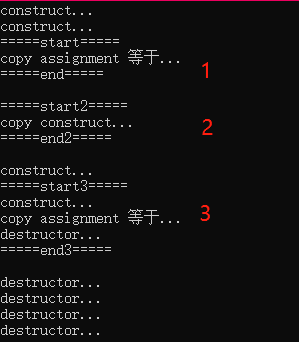1. 左值和右值
简单的定义来说,能够放在赋值等号左边的就是左值,反之则是右值(所有表达式不是左值就是右值,左右值不存在交集)——但是这个解释实在有点鸡肋。下面对定义结合例子做些补充。
- 右值:在内存中不占有内存的表达式
- 左值:在内存中占有一定内存位置的表达式
1 int i; 2 i = 2; //合法 3 2 = i; //非法
例子合法性很好理解——可以在结合左右值的定义。
1 #include<iostream> 2 int main() 3 { 4 int t; 5 int* q = &(t + 1);//非法,t+1在内存中没有位置 6 7 int arr[] = { 1,2,3 }; int r[] = { 1,2,3 }; 8 int* i = arr; //合法 9 std::cout << arr << std::endl; // 006FF808 10 arr = r; // 非法 11 *(arr) = 10;//合法 12 }
在这里,我们需要理解下第八行,arr 作为右值—— 注意 arr 是内存地址,是一个地址,不同于第一个例子中的 i 。在第九行可以看到打印的 arr 代表的地址内容,第十行也就必定是错误的(是右值就不可能作为左值)。
而第11行,arr 貌似变成了左值——也就是左值和右值在一定程度上是可以转换的。其中扮演关键角色的就是 * 解引用。既然是左值,按照我们前面说的,那应该在内存中存在一处分配的内存位置,*arr 解引用之后的确是存了 1 这个数,所以可以重新赋值10。
2. 右值引用
通过下面的例子来理解:
1 #include<iostream> 2 #include<string> 3 using namespace std; 4 struct A 5 { 6 // 构造函数 7 explicit A(size_t _size = 0) :size(_size),ptr(new int[_size]()) { 8 cout << "construct..."<< endl; 9 } 10 11 // 拷贝赋值运算符 12 A& operator=(const A& tmp) { 13 if (&tmp != this) 14 { 15 this->ptr = new int[tmp.size]; 16 for (size_t i = 0; i < tmp.size; ++i) { 17 this->ptr[i] = tmp.ptr[i]; 18 } 19 } 20 cout << "copy assignment 等于..." << endl; 21 return *this; 22 } 23 24 // 拷贝构造函数 25 A(const A& tmp) { 26 this->ptr = new int[tmp.size]; 27 for (size_t i = 0; i < tmp.size; ++i) { 28 this->ptr[i] = tmp.ptr[i]; 29 } 30 cout << "copy construct..." << endl; 31 } 32 33 // 析构函数 34 ~A() { 35 if (ptr) 36 { 37 delete[] ptr; 38 size = 0; 39 cout << "destructor..." << endl; 40 } 41 } 42 43 private: 44 int* ptr; 45 size_t size; 46 }; 47 48 int main() 49 { 50 A a(10); 51 A b; 52 53 cout<< "=====start=====" <<endl; 54 b = a; 55 cout << "=====end=====" << endl << endl; 56 57 cout << "=====start2=====" << endl; 58 A c = a;//是拷贝构造。或者加上explicit改成A c(a) 可能更好理解 59 cout << "=====end2=====" << endl << endl; 60 61 A d; 62 cout << "=====start3=====" << endl; 63 d = A(5); 64 cout << "=====end3=====" << endl << endl; 65 66 return 0; 67 }

结果上看,应该都比较好理解。
其中第三处是要引出的重点,可以看到应该使用了 d = A(10),这条语句,A() 是一个临时变量,在完成 construct -> copy assignment 之后就进行了 destructor。我们来讨论下这一句赋值语句的内部过程,A(10) 调用构造函数并申请了内存空间,然后去实现拷贝赋值运算符,临时变量A(10)的内容【copy】给 d 变量,随后 A(10) 被销毁。而我们知道在 copy assignment (拷贝赋值运算符)方法中,我们又为 d 变量同样申请了 大小为10的数组空间,这就出现了一定的“低效处理”。不妨这样想,如果我们将A(10)申请的空间,通过拷贝赋值运算符,直接将这个空间给变量d,这样d就不用再去申请空间(反正A(10)的空间申请了,马上就会释放。相当于白白多申请和释放了一次,不如直接将A(10)的空间转移到d变量名下)。
这就引入了右值引用,如下例子:
1 #include<iostream> 2 #include<string> 3 using namespace std; 4 struct A 5 { 6 // 构造函数 7 explicit A(size_t _size = 0) :size(_size),ptr(new int[_size]()) { 8 cout << "construct..."<< endl; 9 } 10 11 // 拷贝赋值运算符 12 A& operator=(const A& tmp) { 13 if (&tmp != this) 14 { 15 this->ptr = new int[tmp.size]; 16 for (size_t i = 0; i < tmp.size; ++i) { 17 this->ptr[i] = tmp.ptr[i]; 18 } 19 } 20 cout << "copy assignment 等于..." << endl; 21 return *this; 22 } 23 24 // 使用右值引用的拷贝赋值运算符 25 A& operator=(A&